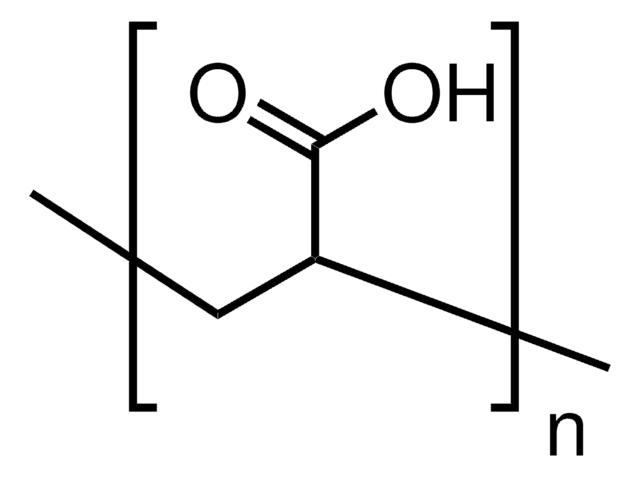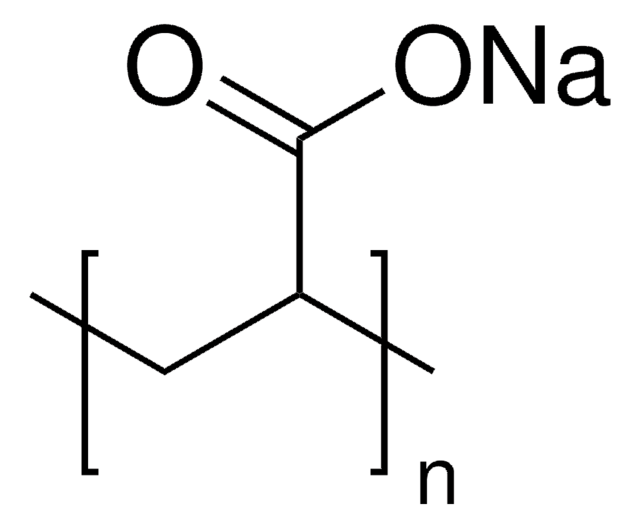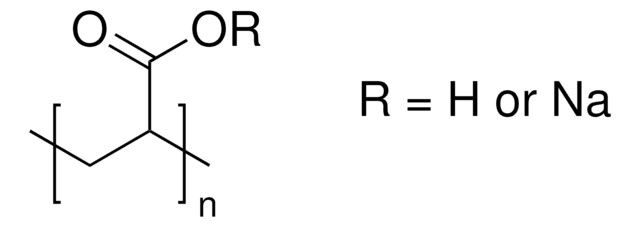535931
Poly(acrylic acid) solution
average Mw ~2,000, 50 wt. % in H2O, electronic grade
Sinonimo/i:
PAA
Autenticatiper visualizzare i prezzi riservati alla tua organizzazione & contrattuali
About This Item
Formula condensata:
(C3H4O2)n
Numero CAS:
Numero MDL:
Codice UNSPSC:
12162002
ID PubChem:
NACRES:
NA.23
Prodotti consigliati
Grado
electronic grade
PM
average Mw ~2,000
Concentrazione
50 wt. % in H2O
P. ebollizione
116 °C
Densità
1.15 g/mL at 25 °C
Stringa SMILE
OC(=O)C=C
InChI
1S/C3H4O2.Na/c1-2-3(4)5;/h2H,1H2,(H,4,5);/q;+1/p-1
NNMHYFLPFNGQFZ-UHFFFAOYSA-M
Cerchi prodotti simili? Visita Guida al confronto tra prodotti
Categorie correlate
Descrizione generale
Poly(acrylic acid) solution (PAA) is an anionic polymer that can be synthesized by the free radical polymerization of acrylic acid. It has a swelling nature that tends to absorb and retain the water. It has a high ion exchange capacity that makes it useful in the development of membranes.
Applicazioni
PAA can be used for a variety of applications such as:
- a surfactant in the formation of photonic crystals
- a binder for the development of Silicon anode based lithium ion batteries
- polyelectrolyte membranes for electronics and optoelectronics based applications
Avvertenze
Danger
Indicazioni di pericolo
Consigli di prudenza
Classi di pericolo
Aquatic Acute 1 - Aquatic Chronic 2 - Eye Dam. 1 - STOT SE 3
Organi bersaglio
Respiratory system
Codice della classe di stoccaggio
10 - Combustible liquids
Classe di pericolosità dell'acqua (WGK)
WGK 1
Punto d’infiammabilità (°F)
Not applicable
Punto d’infiammabilità (°C)
Not applicable
Scegli una delle versioni più recenti:
Possiedi già questo prodotto?
I documenti relativi ai prodotti acquistati recentemente sono disponibili nell’Archivio dei documenti.
I clienti hanno visto anche
Highly tunable superparamagnetic colloidal photonic crystals
Ge J, et al.
Angewandte Chemie (International Edition in English), 46(39), 7428-7431 (2007)
Micropatterning of polymer thin films with pH-sensitive and cross-linkable hydrogen-bonded polyelectrolyte multilayers
Yang SY and Rubner MF
Journal of the American Chemical Society, 124(10), 2100-2101 (2002)
Water absorption, retention and the swelling characteristics of cassava starch grafted with polyacrylic acid
Witono JR, et al.
Carbohydrate Polymers, 103(1), 325-332 (2014)
Alexandre Magasinski et al.
ACS applied materials & interfaces, 2(11), 3004-3010 (2010-11-09)
Si-based Li-ion battery anodes offer specific capacity an order of magnitude beyond that of conventional graphite. However, the formation of stable Si anodes is a challenge because of significant volume changes occurring during their electrochemical alloying and dealloying with Li.
Fast adsorption of methylene blue on polyacrylic acid-bound iron oxide magnetic nanoparticles
Mak S and Chen D
Dyes and Pigments, 61(1), 93-98 (2004)
Il team dei nostri ricercatori vanta grande esperienza in tutte le aree della ricerca quali Life Science, scienza dei materiali, sintesi chimica, cromatografia, discipline analitiche, ecc..
Contatta l'Assistenza Tecnica.





